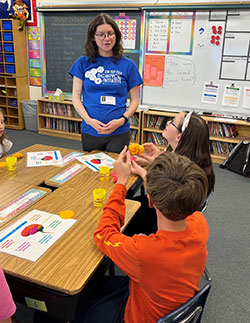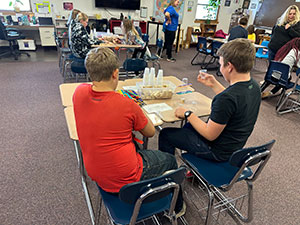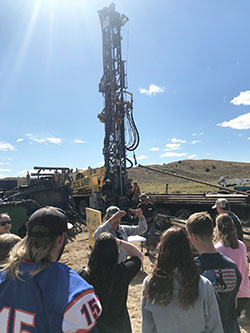UW Science Initiative Roadshow Reaches Record Number of Wyoming Students
Published December 15, 2023

This fall, the University of Wyoming’s Science Initiative Roadshow reached 4,209 K-12 students in six counties through 14 individual events -- the program’s largest one-semester reach since it began in 2017.
Events included four STEM (science, technology, engineering and mathematics) Days that included participation from the UW Wyrkshop Mobile Makerspace; the Wyoming NASA Space Grant Consortium Science Kitchen; the UW College of Engineering and Physical Sciences’ K-14 STEM Education Outreach Office; the Wyoming Game and Fish Department; UW Extension offices; local conservation districts; CyberWyoming; Western Wyoming Community College; and Northwest College.
The Science Initiative Roadshow is a team of undergraduate and graduate students from UW, along with UW instructors, who travel throughout the state facilitating hands-on learning in a range of locations. The teams from UW work with K-12 students to increase excitement and education in the sciences.
“We specifically collaborate with K-12 teachers to integrate learning experiences into existing curricula to achieve assigned learning outcomes or link activities to specific state science standards,” says Erin Klauk, co-director of the Science Initiative Roadshow. “This collaborative approach exposes learners in Wyoming to innovative active-learning techniques and creates links between UW and schools/communities across the state to improve STEM interest statewide.”
Klauk, the Science Initiative Roadshow’s newest hire, led the first event of the semester alongside Karagh Brummond, the other co-director of the program and an assistant instructional professor in the UW Honors College.
Klauk’s community-based project linked students at Hanna, Elk Mountain, Medicine Bow Junior/Senior High School (HEM) with local research occurring in their community. In collaboration with Ellen Currano, a professor of paleobotany in the UW Department of Geology and Geophysics who investigates how ancient ecosystems respond to global change, the Science Initiative Roadshow designed and implemented age-appropriate curriculum to the HEM students to teach about this work occurring in the Hanna area.

While all 14 events this year were meaningful and successful, the Science Initiative Roadshow’s recent STEM Day at Encampment K-12 School in Carbon County was one to highlight, Klauk says. The UW team and collaborators offered 14 different STEM stations for the students to rotate through during the day. K-6 students rotated through one schedule, and students in grades 7-12 experienced other STEM stations.
Students learned about electricity, computer science, beaver ecology, neuroscience, engineering, animal pelts, soils, fossils and ocean acidification.
“It was such a wonderful day. All of our teachers were so impressed with the stations and the presenters, not to mention how well it was planned,” says Leslie McLinskey, a language arts teacher at Encampment K-12 School. “And the kids just had a blast. UW runs a great program, and everyone is already talking about inviting them all back again.”
Partners for the Encampment K-12 School STEM Day included the K-14 STEM Education Outreach Office at UW; the NASA Space Grant Consortium Science Kitchen at UW; the local Wyoming Game and Fish Department office; and the UW Extension office in Carbon County.
“This expansion of our internal and external partners to extend our STEM Day abilities has been instrumental to the success of these programs,” Klauk says.
The remaining STEM stations were designed and delivered by UW undergraduate and graduate students.
For example, Ashleigh Pilkerton, a UW Ph.D. student from Albany, Ore., in the Program in Ecology and Evolution, led two stations -- computer science for grades K-6 and ocean acidification for grades 7-12 -- at the Encampment K-12 School STEM Day.
“STEM Days allow K-12 students to explore and truly experience a wide variety of topics from many STEM disciplines,” says Pilkerton, who works in the Wyoming Cooperative Fish and Wildlife Research Unit at UW. “One of my favorite parts of STEM Days is the opportunity to share the excitement and joy of STEM with a wide range of students using hands-on and interactive lessons. It is an incredibly engaging opportunity to teach Wyoming’s youth about a diverse array of STEM career fields and to get them excited about topics they may not learn about otherwise.”
Alyssa Baldwin, a UW master’s student from Perrysburg, Ohio, studying rangeland ecology and watershed management, had students in grades K-6 build their own beaver dams at various STEM Day events, including at Encampment K-12 School.

Elizabeth Lungren, a UW junior from Ten Sleep majoring in molecular biology and microbiology, worked at the Desert View Elementary School STEM Day in Rock Springs and led an “Animals and Their Environments” activity that was taught to K-3 students. Lungren also worked at the Encampment K-12 School STEM Day and led a human anatomy activity with K-6 students.
“I really enjoyed being able to reach a broad range of students and engage them with a variety of fun activities that they wouldn’t normally do,” Lungren says. “It was great to watch their enthusiasm about the different STEM topics being taught.”
Quiana Jeffs, a third-year Ph.D. neuroscience student from Austin, Texas, taught brain science to K-5 students at the Spring Creek Elementary School STEM Day in Laramie. The activity involved showing students actual brains from several kinds of animals; having the students guess the animals the brains came from; and discussing similarities and differences among the various animal brains. This led into an activity in which students were asked to each think of a favorite animal and make a mold of what they think the brain of that animal would look like based on what was taught in the lesson.
“The students I worked with that day were excellent listeners and asked phenomenal questions,” Jeffs says. “Everyone was super enthusiastic and excited to see real brains, which was very rewarding for me to be able to provide. The kids came up with great brains to match their animals and seemed to really grasp the idea that different brain properties can give rise to different abilities.”
Austin Bernard, a UW senior from Santa Cruz, Calif., majoring in mechanical engineering, has taught engineering, 3D modeling, physics and an engineering design challenge to grades K-12 at many of the STEM Day events.
“The experience has been fun at each school, and each had its highlights,” he says. “But my favorite was when children would say that they wanted to become what I am because of what I have taught them.”
The Science Initiative Roadshow is set up for another record-breaking spring, with plans to offer 15 outreach events across eight counties, Klauk says. These activities will include five scheduled STEM Days, one of which will be hosted at the new Eastern Wyoming Nature Center in Lusk.
If a school or program is interested in collaborating with the Science Initiative Roadshow to offer hands-on STEM activities to students and communities in the state, email Klauk at eklauk@uwyo.edu or Brummond at kmurph17@uwyo.edu.

